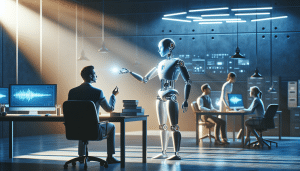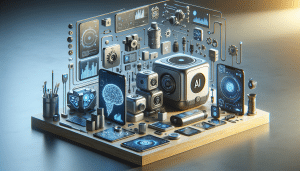The Surprising Ways AI Already Impacts Your Everyday Life
Aiden Foster October 18, 2025
Artificial intelligence shapes more daily experiences than most people realize. This guide explores how AI powers personal devices, healthcare, finance, and work routines—uncovering both the visible and invisible roles it plays. Learn how emerging technologies continue to redefine what’s possible and what these changes might mean for individuals and society.
The Unseen Presence of Artificial Intelligence
Artificial intelligence has quietly become an integral part of many daily activities, often going unnoticed because of its seamless integration. Algorithms analyze your favorite shows to suggest titles on streaming platforms. Voice assistants handle requests like setting reminders or searching for facts, making convenience easy. Even navigation apps that reroute you around traffic use AI-driven data analysis techniques to keep journeys smooth.
From the moment a smartphone is unlocked with facial recognition to the personalized news articles presented during an online search, artificial intelligence works in the background for everything. These technologies use complex machine-learning processes to provide efficiency, relevance, and security. The evolution of AI means tasks we once did manually—like sorting emails or correcting spelling mistakes—now happen automatically in the digital world.
Invisible systems monitor fraud in financial transactions, quietly protecting consumers and institutions alike. In this way, artificial intelligence, even if subtle, consistently shapes decisions and behaviors.
For many, the extent of artificial intelligence’s reach isn’t obvious. Beyond media or smart gadgets, AI is deployed by industries for purposes such as supply chain management, predicting customer preferences, and optimizing logistics. Businesses receive recommendations on inventory restocking, while consumers enjoy tailored shopping experiences thanks to advanced pattern recognition.
Retailers use AI tools to anticipate demand, detect shopping trends, and even help design products that resonate with buyers. In homes, connected devices—such as thermostats—use intelligent models to learn residents’ routines and adjust environments for comfort and energy savings. These convenient tools are possible because of continual advances in data processing and neural networking.
The power of artificial intelligence also means companies can respond rapidly to complex market fluctuations. Data-driven business models allow for nearly real-time analysis, helping organizations innovate faster.
The versatility of artificial intelligence is evident across industries. Healthcare professionals leverage AI support systems during patient triage, insurance companies detect fraudulent claims, and even agricultural businesses use machine learning to predict crop yields. These innovations reflect a growing reliance on intelligent automation, making it a critical resource for efficiency and advancement.
Academic institutions are also involved, using AI to process large-scale research data and facilitate learning environments for students. Intelligent tools can now translate languages instantly, break down complex scientific articles into understandable segments, and guide research. Everyday actions—from making purchases to seeking entertainment—are enhanced by the constant, yet often unseen, presence of AI. This deep integration signals a profound shift in how society interacts with technology.
Healthcare’s Quiet Revolution with AI
AI-driven diagnostics are transforming healthcare by enhancing accuracy and speed. Radiologists rely on machine learning systems to quickly identify abnormalities in MRI and X-ray scans, often finding patterns that human eyes might miss. This analytical precision supports clinicians in making informed decisions, potentially improving patient outcomes.
Remote monitoring tools also employ AI algorithms to alert medical professionals about sudden changes in vital signs—sometimes before symptoms are even noticeable to patients. Wearables track activity, heart rate, or sleep patterns, sending analyzed data for proactive care. These advancements help bridge gaps in healthcare access, especially for those not able to visit clinics regularly.
Artificial intelligence is advancing personalized treatment strategies for complex conditions. Programs use huge datasets from past cases to suggest effective therapies or flag likely complications. In mental health, virtual AI chatbots provide initial assessments, offer emotional support, and connect individuals to appropriate resources.
AI accelerates drug discovery through computational simulations, helping researchers understand how compounds might interact with diseases. This shortens development times compared to traditional methods, potentially bringing life-saving medications to market faster. The result is not only improved efficiency but also greater access to novel therapies in previously underserved communities.
Public health organizations benefit from AI-driven disease surveillance. Machine learning models forecast flu outbreaks, track emerging viruses, and identify populations at risk, enabling a rapid response. Administrative workflows, including patient scheduling and billing, leverage automation to reduce error rates and enhance service.
Even traditional medical devices like glucose monitors or blood pressure cuffs incorporate AI to detect irregularities. The ongoing integration of AI in healthcare continues to shape a new standard of care—one focused on early intervention, accuracy, and resource optimization. As adoption grows, so does the potential to improve public health globally.
Artificial Intelligence at Home and Work
AI-powered assistants handle a growing share of tasks at home and increasingly in the workplace. Smart speakers can answer questions, control lights, play music, or add items to a shopping list. At work, employees use AI-driven software to automate repetitive tasks, categorize emails, and even analyze large amounts of business data for actionable insights.
This improving efficiency provides more time for creative or strategic endeavors. Project managers employ AI to track deadlines, allocate resources, and identify risks. These collaborative tools reduce the likelihood of human oversight and often result in more informed decision-making throughout an organization.
Complex scheduling is made easier through intelligent platforms that factor in colleagues’ availability and priorities—minimizing conflicts. Language models generate summaries from meeting transcripts, saving hours of manual note-taking. For remote and hybrid workforces, AI-driven platforms monitor productivity and suggest workflow changes to optimize results.
At home, robotic vacuum cleaners map floor layouts and clean with minimal input, while connected refrigerators recommend shopping lists and recipes based on what’s inside. These convenience-boosting devices make busy lifestyles more manageable. As smart devices proliferate, more households experience a taste of the “smart” future enabled by artificial intelligence.
The impact goes beyond practical automation. AI can improve accessibility for those with disabilities, offering real-time speech recognition, personalized reading assistance, and environmental controls. In collaborative environments, brainstorming tools help teams surface creative ideas by generating prompts and connecting unrelated concepts. Artificial intelligence’s influences are expanding quickly—empowering individuals and organizations to work and live in more adaptive, responsive ways.
Enhancing Security and Privacy in a Connected World
Security protocols increasingly depend on artificial intelligence. Advanced programs scan network traffic, detect suspicious activity, and automatically block threats—sometimes before users are aware they exist. Financial institutions use AI to spot unfamiliar patterns in credit card transactions, proactively reducing fraud and unauthorized spending.
Biometric authentication, like fingerprint or facial recognition, adds additional security layers. These systems learn over time, adapting to new threats while ensuring user convenience during the login process. The same technology is used to secure smart homes, with AI analyzing motion sensor data or video feeds to promptly identify intruders.
While AI improves security, it also raises new privacy considerations. With vast amounts of personal data processed, organizations must prioritize ethical data management practices. Artificial intelligence systems use anonymized or encrypted information for analysis to minimize risks and build trust.
Many platforms now let users control what data is collected, and governments have started implementing regulations to safeguard private information. Effective oversight ensures AI technologies remain transparent, earning public confidence. Balanced solutions consider both the immense security benefits and the rights of individuals—something critical as digital connections increase worldwide.
AI-based cybersecurity tools are continuously updated to address evolving threats. Automated systems quickly adapt to new malware or hacking methods, allowing for near-instant detection. As more devices become interconnected—from smartwatches to entire networks—artificial intelligence helps create layered security measures.
Collaboration among tech companies, researchers, and policymakers is vital. Ongoing education about data privacy empowers people to make informed choices about their digital presence. With AI, security is not just reactive but increasingly predictive, giving individuals and businesses a better chance to prevent breaches before they occur.
AI’s Role in Education and Personal Development
AI is integral to personalized learning experiences. Students use adaptive software that tailors reading levels, learning pace, and assessment style. These intelligent systems identify gaps in understanding and recommend exercises for improvement, resulting in more effective study sessions.
Teachers benefit too, with AI tools that automate grading, highlight progress trends, and support differentiated instruction. In higher education, AI assists with research by helping students gather, synthesize, and analyze large datasets. Such tools enable discovery and encourage critical thinking, opening new opportunities for learners worldwide.
Professional skills training is evolving thanks to artificial intelligence. Interactive programs simulate real-world scenarios—like coding, language learning, or business negotiation—providing feedback and progress tracking. AI-powered coaching apps give personalized suggestions based on user strengths and areas for growth.
This approach makes lifelong learning more attainable for a broader audience. Anyone with access to a smartphone or computer can build new competencies at their convenience. Organizations also invest in reskilling employees using AI programs that track workforce trends and recommend upskilling paths for career development.
Even outside formal education, AI-driven content recommendation engines suggest articles, podcasts, or courses based on user interests. Learners explore new topics through curated platforms, experiencing education as a daily, dynamic journey. By lowering barriers and customizing pathways, artificial intelligence helps turn curiosity into actionable knowledge—supporting personal and professional growth for all age groups.
Future Directions: What to Watch as AI Grows
Artificial intelligence is rapidly evolving. In the coming years, expect increased transparency in how AI systems make decisions, as well as more collaborative robots working alongside humans. Ethical guidelines are emerging to help ensure fairness, avoid discrimination, and support responsible use.
Fields such as climate science and energy management use AI to model environmental changes and optimize resource use. In transportation, autonomous vehicles employ advanced AI systems to increase safety and efficiency. The influence of artificial intelligence continues to spread as research and investment increase globally.
Concerns include algorithmic bias, transparency, and job displacement due to automation. Stakeholders from business, academia, and government examine these topics, developing best practices for responsible AI deployment. Open dialogue and continuous learning are essential for addressing complex challenges and unlocking AI’s full potential.
Educational programs and public workshops introduce people to AI fundamentals, preparing society for new opportunities and risks. By understanding the underlying technologies, individuals and organizations can make informed choices as artificial intelligence becomes more pervasive.
Artificial intelligence offers tremendous promise with appropriate oversight and thoughtful integration. The next chapter will depend on society’s ability to balance innovation with ethical consideration. Remaining informed about how AI impacts daily life will enable people to adapt, benefit, and contribute to shaping the connected future. Learn more as this evolving technology continues to surprise and inspire.
References
1. National Institute of Standards and Technology. (n.d.). Artificial Intelligence. Retrieved from https://www.nist.gov/artificial-intelligence
2. European Commission. (n.d.). Artificial Intelligence. Retrieved from https://digital-strategy.ec.europa.eu/en/policies/artificial-intelligence
3. U.S. Food and Drug Administration. (n.d.). Artificial Intelligence and Machine Learning in Software as a Medical Device. Retrieved from https://www.fda.gov/medical-devices/software-medical-device-samd/artificial-intelligence-and-machine-learning-software-medical-device
4. Stanford University. (n.d.). AI Index Report. Retrieved from https://aiindex.stanford.edu/report/
5. Harvard Business Review. (n.d.). The Business of Artificial Intelligence. Retrieved from https://hbr.org/cover-story/2019/07/the-business-of-artificial-intelligence
6. Brookings Institution. (n.d.). Artificial Intelligence and the Future of Work. Retrieved from https://www.brookings.edu/research/artificial-intelligence-and-the-future-of-work/








